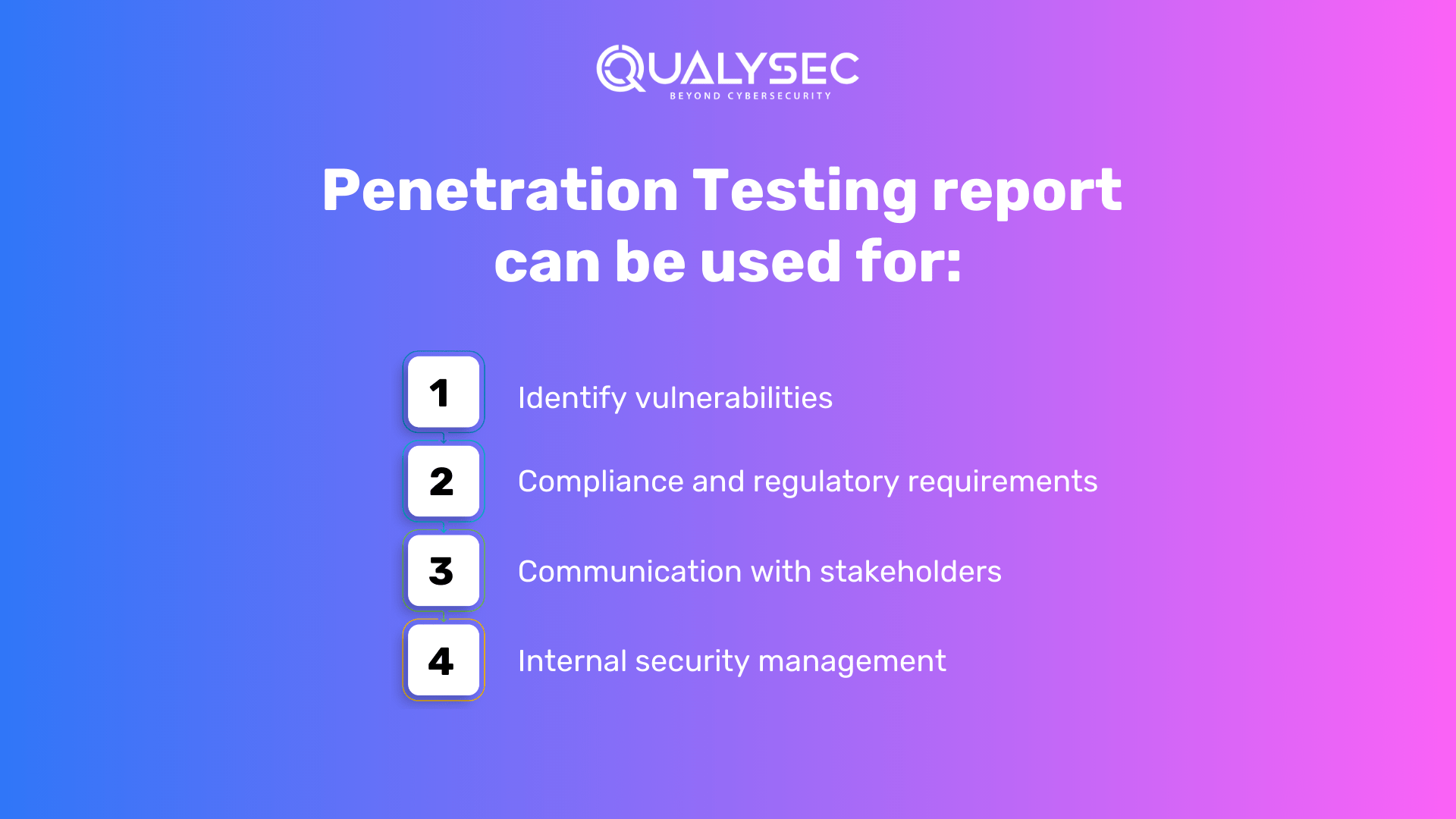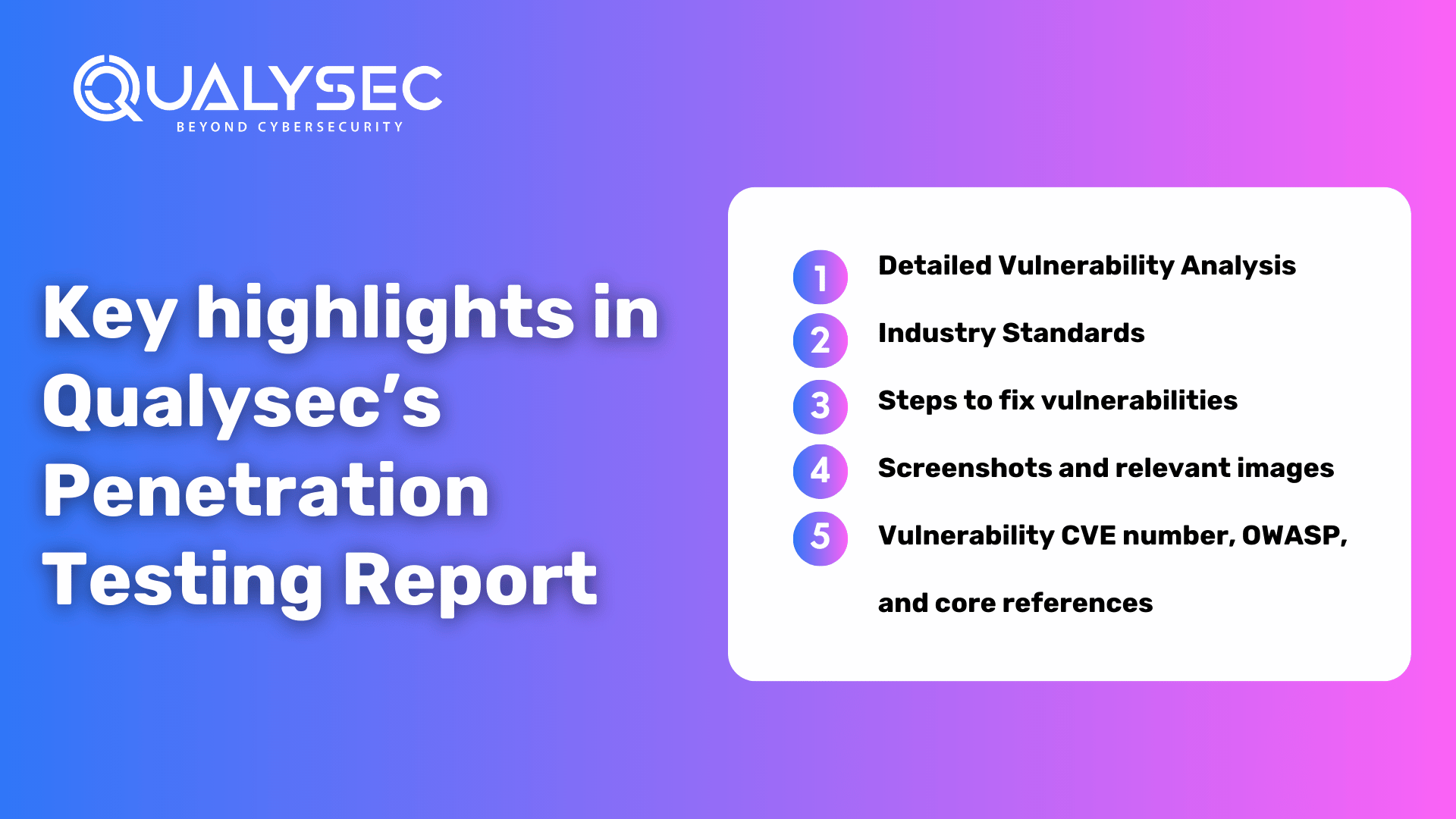As penetration testing service providers, we understand how vital a quality penetration testing report is for both the organization and its developer team. And it is believed that one way to find a good penetration testing company is to look for the penetration testing report they provide. This blog highlights all the things related to penetration testing report.
Talk to our Cybersecurity Expert to discuss your specific needs and how we can help your business.
What is a penetration testing report?
A penetration testing report is a comprehensive document highlighting the vulnerability findings, security flaws, analysis, recommendations, and references leading from a cybersecurity assessment called penetration testing or ethical hacking. The primary objective behind a penetration test is to identify vulnerabilities and security threats in the target’s application or digital asset. Malicious attackers can exploit their vulnerabilities. So, it must be fixed and secured before cyber attackers can do it.
The penetration testing report is an essential communication tool between the experts and the client’s organization.
When is a penetration testing report used?
After performing the test for an organization, a pentesting team member prepares the penetration testing report. This detailed penetration test report aims to assist the organization’s developer team in fixing application security vulnerabilities. The report can guide them to determine what steps to follow next to secure the company’s security posture.
Penetration Testing report can be used for:

1. Identify vulnerabilities:
A penetration tester performs a test to identify vulnerabilities attached to the organization. These vulnerabilities may become a gateway for cyber attackers to enter and exploit them for their benefit. Pen testers will prevent this from happening, as they will find and exploit vulnerabilities and data breaches earlier. The pen tester will also document how they exploited the vulnerabilities, which can help the organization’s technical team identify and fix them accordingly.
2. Compliance and regulatory requirements:
Many industries and countries have different cybersecurity regulations and industry standards that organizations are bound to obtain. Penetration testing reports provide evidence about conducting assessments and addressing vulnerabilities. These reports can play a vital role during security audits to demonstrate compliance and regulatory requirements such as PCI-DSS, GDPR, HIPAA, SOC 2, etc.
3. Communication with stakeholders:
The organization also uses Penetration Testing reports as a security test document in front of many stakeholders, IT personnel, developers, and board members, as the report provides an overview of the organization’s security background, its strengths and weaknesses, and measures taken for improvement. By seeing everything, including vulnerabilities and their potential impacts, organizations can facilitate informed decision-making for further security improvements.
4. Internal security management:
Penetration Testing report is used for understanding the organization’s security. The findings and recommendations mentioned in the report can guide the internal security team to implement improved or advanced techniques of security controls, configurations, and employee awareness and increase investment in security infrastructure to strengthen the organization’s security management.
What are the components of a Penetration Testing report?
A well-written penetration testing report will provide clear and applicable recommendations that can be used to improve the security system of an organization. The penetration testing report should be easy to comprehend for technical teams and non-technical departments.
The following are the components of a good penetration testing report:
1. Executive Summary: the Executive Summary of a penetration testing report contains the overview of the assessment’s goals and objectives, scope, and findings. This part also provides information about the discovered vulnerabilities and recommendations to fix them.
2. Introduction: The report’s introduction elaborates on the motives behind conducting the penetration test. The goals and scope of the test are also described in this part, helping the report reader, mainly the organization’s technical team, to understand the purpose of the assessment.
3. Methodology: the next part of the report discusses the methods employed during penetration testing. For example, at Qualysec, we use a comprehensive approach, automated and in-house tools, and manual testing to find vulnerabilities. So, when writing a report, they will provide insights into how vulnerabilities were discovered with the help of which tools and how they were exploited. In addition, the difficulty of exploiting is rated as Critical, High, Medium, Low, and Minimal—similarly, the vulnerability’s impact on the organization after exploitation is rated.
4.Scope and Limitations: The scope and limitations part of the pentesting report describes the systems, applications, and networks tested. A clear description of what should and shouldn’t be included in the assessment is also mentioned. In short, it helps the reader understand the test’s boundaries.
5. Findings: the penetration testing report’s findings are one of the significant parts. This part describes all the vulnerabilities identified, weaknesses, and data misconfiguration during the process. For every vulnerability found, there is a description along with a severity level (critical, high, medium, low, and minimal), and each finding includes a description, its consequences, instances, steps to reproduce, and POC and remediation.
6. Recommendations: the recommendation part of the report addresses the vulnerabilities discovered in the findings. For every vulnerability, the recommendation is unique, specific, and practical in application. Moreover, the reader should apply those recommendations as per the severity of the vulnerabilities.
7. Steps to reproduce and POC: step-by-step POCs support validating the existence of the vulnerabilities. This evidence helps the users to know in detail how the pen tester found the vulnerability and its exact location. Screenshots with highlight codes are also attached for clear understanding.
8. Remediation: this section of the findings is primarily for the organization’s development team, as clear and well-written remediation support is given on how to deal with the vulnerabilities. The pen testers mention every measure and process for the developer.
Why is penetration testing report important for organizations?
With the growth of digitalization, the need to strengthen cybersecurity also grows. When entering an organization’s application software, a cyber attack can cause severe financial damage and brand reputation.
Penetration testing service providers can prevent cybercrime, as they will find vulnerabilities and fix them before they get exploited by cyber attackers. Pen testers or ethical hackers also prepare a report describing your organization’s whole process.
This report will not only give an in-depth explanation of the assessment but also help the developer team to understand their security system better and implement recommended measures to fix those vulnerabilities.
The following points explain why penetration testing reports are essential for an organization.
1. Building Trust:
Whether small or large, an organization maintains a relationship with different people, including clients, loyal customers, stakeholders, and partners. They expect that their information and details remain confidential. The penetration test report can be used to maintain that trust, proving to the customers and clients that the organization is secure and has performed a penetration test. Moreover, pen testers perform a retest before providing a letter of attestation and security certificate confirming that all the vulnerabilities are now addressed, and the organization is secure.
2. Supporting budget allocation:
A penetration testing report can help the organization plan the allocation of budgets for cybersecurity initiatives. Every organization has a different way of prioritizing the list of things, and detailed reports given by pen testers help understand resources for further security improvements. The technical team can sort out the application weaknesses that need immediate attention.
3. Documentations:
A penetration testing report is supported by constant monitoring and documentation of the security management of an organization’s digital assets. Moreover, having proper documentation ready will also benefit in meeting the compliance and regulatory requirements such as PCI-DSS, GDPR, SOC 2, and more for the overall improvement of the organization’s security.
4. Penetration test report by Qualysec
Qualysec’s penetration testing report is carefully designed to maintain a clear understanding and communication between the target organization and our team. We deeply understand how vital a penetration testing report is.
That’s why we mention every existing security threat and weakness in our penetration testing report—followed by the recommendation and steps to reproduce and POC.
Some key highlights in Qualysec’s penetration testing report:

1. Detailed Vulnerability Analysis:
Qualysec’s penetration testing report shows a detailed analysis of vulnerabilities and security threats along with their severity that is measured by (critical, high, medium, low, and minimal), affected applications or locations, its detailed description, consequences, instances, steps to reproduce, and POC and remediation—making it easy and direct for the technical team of the target organization.
2. Industry Standards:
Qualysec’s expert pen testers carry out industry standards penetration testing. Over 3000+ tests to detect and root out all types of vulnerabilities followed by the OWASP and SANS guidelines and compliance requirements to test various vulnerabilities.
3. Steps to fix vulnerabilities:
A penetration testing report will give steps to fix every security threat or vulnerability identified after describing their potential consequences. It will also showcase the remediation support follow-ups to clearly understand what to do and what not to do when some security flaw occurs.
4. Screenshots and relevant images:
The penetration testing report provided by Qualysec doesn’t only contain descriptive information about the vulnerability and measures. The report also contains relevant images and screenshots showcasing the locations and method process applied. These pictures also show the vulnerability identified in the organization’s security application software. Through images, it becomes much easier for the technician to pinpoint the exact locations of the conduct.
5. Vulnerability CVE number, OWASP, and core references:
Toward the end of the penetration testing report, Qualysec’s pen testers will mention the Common Vulnerabilities and Exposures (CVE) number that identifies specific vulnerabilities from the list. The organization can consider this CVE number for planning and prioritizing its cybersecurity. Similarly, our pen tester will also point out the rank of the vulnerability in OWASP and set a standard awareness for the technical team to address the severity of the security threats listed in the OWASP.
Qualysec also has a section called core references in the penetration testing report. The section includes all the links the technical team member can refer to when looking for the best recommendations and practices to improve their security posture.
Latest Penetration Testing Report

Conclusion
An organization goes through a lot of changes throughout the year. The constant upgradation in technology is also making them tag along for growth in the industry. Sometimes, security threats, flaws, or unauthorized activities may happen, for which penetration testing reports can help deal with the weaknesses and vulnerabilities.
The role of penetration testing reports is not limited. It has various benefits and can be considered a comprehensive guide for the technical team of an organization.
At Qualysec, we are determined to help businesses to identify and resolve vulnerabilities with our hybrid framework. With every project we have worked on, we have provided a detailed penetration testing report to our clients so that they can sit back and rest assured and don’t get trapped in the complex process of dealing with vulnerabilities and security risks.
If you want our penetration testing experts to help you with your organization’s security threats, connect with us now.















































































































































































































































































































































0 Comments